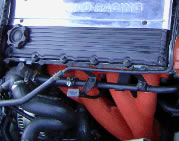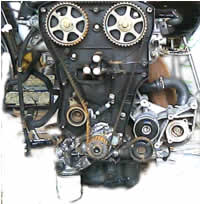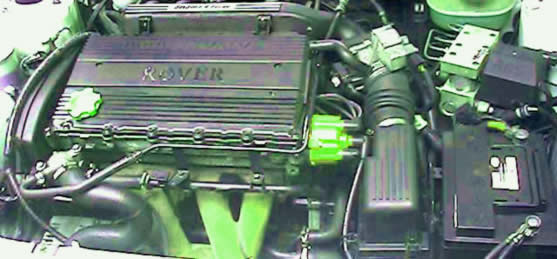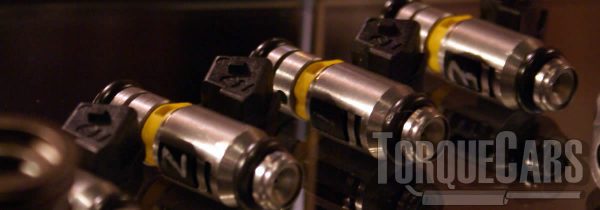Rovers T series 2.0 engine
"All you need to know about performance tuning the Rover T series 2.0 engine!"
The Rover T series 2.0 are popular tuning projects and with the ultimate tuning upgrades like a remap, turbo improvements and camshafts you will positively increase your driving experience.
This pages aim is review and look at T series 2.0 tuning and highlight the best modifications for your car.
History, Power & Specs of the Engine
 The engine in the car is a 2 litre Multipoint fuel injection systems controlled by Rover MEMS engine management system.
The engine in the car is a 2 litre Multipoint fuel injection systems controlled by Rover MEMS engine management system.
The Rover T series great bases for a tuning project and with the right tuning modifications like a remap, turbo kits and camshafts you will dramatically enhance your driving opportunities.
Here we look into T series tuning and show the greatest upgrades.
In standard form it generates 136 bhp - 0-60 in 7.8 seconds (not bad) and returns between 20 and 25 mpg (31 when rebuilt) - doesn't matter if I drive it hard or not!!
Best T series 2.0 modifications
We won't be swayed by popular T series tuning mods, they need to be cost effective.
The camshaft profile plays a big part in the engines power output so camshaft upgrades make quite a large difference. The intake and exhaust durations will alter depending on the chosen camshaft profile, so large engines power gains are on offer for camshaft upgrades.

Fast road cams commonly push up the torque throughout the rpm range, you could drop a little low end power but your higher rpm power will improve.
Motorsport and race cams, push up the higher rpm power band but as a result the car will not idle smoothly and low end power nearly always suffers.
In a car driven daily must carefully try to optimize your bhp range to your driving style.
I would be surprised if you have found a T series Race cam is a pleasure to live with when in heavy traffic because low end power will be very lumpy. Competition cams are designed for maximum power at the top end of the RPM range, a place that most daily commutes will not permit!

Each engine responds better to less aggressive camshaft durations than others.
The map and fuelling also have an effect on the torque gains you'll get.
Extending exhaust or intake durations can alter the torque band and on most engines the exhaust and intake durations do not need to match, although most cams and tuners use matched pairs there are some advantages to extending the intake or exhaust durations.
Please watch our video which covers the 5 principles of tuning your car. Be sure to keep up with our latest YouTube content and subscribe.
Best Engine Mods for your car
- Engine Tunes - engine tuning/remapping provides the most advantage in terms of cost savings, aftermarket ECUs, and piggyback ECUs are all alternatives.
- Fast road cams are one of the most significant mechanical changes, but they must be installed by someone who knows what they're doing and they are not always easy to source but you might find a local firm to regrind a stock camshaft.
- Intake and Exhaust - Note that on their own these mods will NOT ADD POWER in most cases, but they can help enhance power after other mods by removing the restriction.
- Upgrades to turbochargers and superchargers - forced induction is the most efficient approach to increase air supply, allowing you to burn more fuel and make more power. It is one of the most costly upgrades but provides the best gains.
- Head work - The goals of porting and flowing the head are to get air flowing into the engine while removing flow restrictions and turbulence.
Typical stage 1 mods often include: Sports exhaust header/manifold, Intake manifolds, Remaps/piggy back ECU, Panel air filters, drilled & smoothed airbox, Fast road camshaft.
Typical stage 2 mods often include: fuel pump upgrades, Sports catalyst & performance exhaust, Ported and polished head, induction kit, high flow fuel injectors, Fast road cam.
Typical stage 3 mods often include: Crank and Piston upgrades to alter compression, Twin charging conversions, Adding or Upgrading forced induction (turbo/supercharger), Engine balancing & blueprinting, Competition cam, Internal engine upgrades (head flowing porting/bigger valves).
Remaps should help to fully realize the full potential of all the upgrades you've fitted to your T series.
(In some cases, as the factory ECU is locked flashing is not an option, so an aftermarket ECU is the route to take, and many of these will outperform factory ECU's but make sure it has knock protection and that you get it setup properly.)
It will usually give you around 30% more power on turbocharged vehicles and you can expect to see around 15% on NA (naturally aspirated) engines, but your mileage usually depend much on the upgrades you've carried out and the condition of your engine.
Shoving more fuel and air into your T series is the main goal to any performance tuning job.
Air Intake manifolds carry the air during the suck phase from the air cleaner and allow it to be sucked into the engine and mixed with fuel.
Design and flow rate of the Plenum can make a substantial improvement to fuel atomisation and engine efficiency on the T series.
I usually find plenum chambers are begging for an upgrade, although some car makers provide well optimised plenum chambers.
Adding a T series larger valve kit, getting port work and head flowing will also improve torque, & more importantly will afford you an improved torque increase on other upgrades.
My 2.0 T series project experiences
Power was fairly uninspiring up to about 2000 revs - at 3000 rpm the engine really starts to pull (this changed significantly when the engine was rebuilt!).
Rover told me it was an LT series build engine and other companies have told me it's a T Series engine.
First gear hits about 30mph at redline and 2nd gear will see 60. Mid range power and torque are superb from this car.
The car does not have a turbo engine (yet) this sees a sub 6.5 second sprint to 60 and puts out 190bhp in standard form 'easily' tweakable to 250bhp
(By increasing the boost and adding air filter & decat exhaust & bolting on an ICON race computer, and I've also been informed you would also need a front mounted intercooler and water injection at this sort of power level.)
A turbo conversion would need a new gearbox as the standard gearbox is not strong enough to handle all of that power!
A tweaked turbo engine could also wreck the standard turbo gearbox already noted as a weak spot in the turbo (Tomcat) models
Modding the standard car could easily cost more than buying a turbo engine for conversion from a scrap yard donor. If you do switch in a turbo engine you'll need the donor MEMS and I suppose the immobiliser would need the original locking mechanism as well.
 The clever thing about the Rover engine is that the MEMS engine management unit does not have tightly pre programmed ignition timing settings - it learns from your car and the way in which you drive it.
The clever thing about the Rover engine is that the MEMS engine management unit does not have tightly pre programmed ignition timing settings - it learns from your car and the way in which you drive it.
After sniffing the exhaust fumes, looking at the load on the engine, the revs per minute and readings from sensors around the engine and comparing this with the last 200 miles driven it calculates the best fuel delivery and ignition timing .
My old engines sensor returned 1 pulse in every revolution of the crank whereas other engines (newer versions) can operate on 4 pulses every revolution (Including the rebuilt engine I added which had its original sensor) - you must ensure that the crank sensor you have is the compatible with your MEMS unit otherwise the car will not run and you'll have to take off the gearbox, flywheel and pull out the crank sensor and change it for the correct one.
Gladly the correct crank sensor (the one from my first engine) sorted out the problem and the engine fired into life.
When you drop in a new engine or heavily modify an engine it may not run smoothly for a while - mine took about 200 miles before it ran smoothly I guess it has to learn the new timing settings to use.
A recon engine with a crank grind gave me loads of torque low down (pulling very well from 1000 rpm) - and massive '!' fuel economy of 31 - 32 mpg!!

The rebuild engine is back and installed and it is running sweet - the car literally purrs and the 3'' Scorpion exhaust sounds fantastic - a real deep power sound.
My new fully reconditioned/rebuilt engine fitted - going really well more power - smoother and more refined this is the later engine from a Rover 800 - the mounts are different but the basic engine is the same T series (The Rover 600 2.0 engine also needs different mounts and the 600 gearbox will not fit a 200,400 or 800 easily as it is hydraulic!)
It should be putting out more power - the compression has been increased and the whole inside has been tidied up and polished, crank polish/grind new piston rings etc and with a better flowing exhaust and a piper-x air filter things are much easier going now and it purrs like a kitten I reckon we are getting closer to the 175bhp I wanted - will get the car dyno tested soon when it's been run in.
I am so pleased with the way the car is running now - I'm allowing a rather long, 1000 miles to fully bed in the new pistons and I can then start to really see what the car is capable of - I'll have to stick to 55mph 2500 rpm in 5th gear for the moment!
The engine is now run in (It took me over a year to do the mileage) - things got better and better as everything bedded in. Now its run in I have used X1 superlube to protect the engine. I find Shell optimax to be the best fuel in terms of performance other 'supers' seem to cause a burbly tickover.
Turbo upgrades

NA (naturally aspirated) engines need quite a lot of work when you add a turbo, so we have a separate guide to help you take into account the pros and cons of going this route on your T series
The more air you can get into an engine, the more fuel it can burn and uprating the induction with a turbocharger upgrade makes excellent power gains.
If an engine is turbocharged, modifications are giving better power gains and you will discover turbo engines are made using more solid components.
There are tuning limits for every engine, with some being incredibly solid and some only just able to handle stock power
Discover these restrictions and install stronger pistons, crank and engine components to utilize the power.
There are many people spending a loads on turbocharger upgrades on the T series only to have the motor throw a rod just after it's been enthusiastically driven.
Larger capacity turbo units commonly experience a bottom end lag, and little turbo units spool up really quickly but don't have the peak rpm bhp gains.
Over the last 20 years the selection of turbos is always improving and we commonly find variable vane turbos, permitting the vane profile is altered according to speed to lower lag and increase top end power.
Twin scroll turbos divert the exhaust gases into 2 channels and push these at differently designed vanes in the turbocharger. They also increase the scavenging effect of the engine.
It is not unusual that there's a limit in the air flow sensor MAP/MAF/AFM on these engines when considerably more air is being drawn into the engine.
We see 4 bar air sensors coping with quite large power gains, whereas the OEM air sensor limited torque at a much lower level.
Fuelling
Don't omit to increase the fuel delivery when you are increasing the power - it makes the car more thirsty.  We would recommend you to be generous with your injectors flow rate.
We would recommend you to be generous with your injectors flow rate.
The accepted safe increase is to add another 20% when specifying an injector, this allows for injector deterioration and allows a bit of spare capacity should the engine need more fuel.
We think this one is common sense, but you'll need to match your fuel injector to the type of fuel your car uses as well.
All the following flywheel power targets will assume an injector duty cycle of 80% and a base of 58psi of fuel pressure at idle.
4 Cylinder turbocharged engines
- 58 PSI 340cc/min 200hp
- 58 PSI 511cc/min 300hp
4 Cylinder NA (naturally aspirated) engines
- 58 PSI 285cc/min 200hp
- 58 PSI 426cc/min 300hp
Exhaust
Only look to upgrade your exhaust if the current exhaust is creating a flow problem.
On most factory exhausts you should find that your flow rate is ok even on modest power gains, but when you start pushing up the power levels you will need to get a better flowing exhaust.
Sports exhausts will certainly help air flow through the engine but avoid an exhaust that is too wide or you might just stuff your flow rate and make things worse. So generally speaking, keep to a size of 1.5 to 2.5 inches for best results.
Common exhaust restrictions are traced to the catalyst and filters installed, so adding a freer flowing high performance aftermarket one will improve air flow, and rather than doing an illegal decat, will keep the car road legal.
Out of interest the old ratios were 28 mph 1st gear redline / 58 mph 2nd Gear redline 3rd gear became illegal speeds so I didn't record a figure for it.
Please Check out my YouTube channel, we're regularly adding new content...
PLEASE HELP: I NEED YOUR DONATIONS TO COVER THE COSTS OF RUNNING THIS SITE AND KEEP IT RUNNING. I do not charge you to access this website and it saves most TorqueCars readers $100's each year - but we are NON PROFIT and not even covering our costs. To keep us running PLEASE Donate here
If you liked this page please share it with your friends, drop a link to it in your favourite forum or use the bookmarking options to save it to your social media profile.
Feedback - What do You Think?
Please use our forums if you wish to ask a tuning question, and please note we do not sell parts or services, we are just an online magazine.
Help us improve, leave a suggestion or tip
Please watch this video and subscribe to my YouTube channel.

 Click to accept YouTube Cookies & Play.
Click to accept YouTube Cookies & Play.